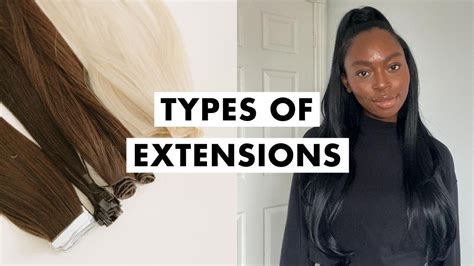In the vibrant world of hair transformations, hair extensions have emerged as a versatile tool to enhance length, volume, and style. From subtle enhancements to dramatic transformations, extensions offer endless possibilities for hair enthusiasts of all types. This comprehensive guide will delve into the various kinds of hair extensions available, providing in-depth insights into their characteristics, applications, and advantages.

Tape-In Hair Extensions: The Discreet Choice
Tape-in hair extensions, also known as sandwich extensions, are renowned for their seamless integration and comfortable wear. Thin, flexible polyurethane tapes are attached to the top and bottom of the extension strands, which are then sandwiched around the natural hair.
Advantages:
- Virtually undetectable
- Less damaging than other methods
- Long-lasting (up to 6-8 weeks)
Disadvantages:
- Can be time-consuming to install
- May not be suitable for fine or thin hair
- Can loosen over time
Clip-In Hair Extensions: Transform in Minutes
Clip-in hair extensions are the epitome of convenience, allowing instant volume and length without any commitment. With pre-attached clips, these extensions simply snap into place at the roots of the natural hair.
Advantages:
- Quick and easy to install
- Versatile for temporary or semi-permanent use
- Affordable option
Disadvantages:
- Can be visible if not blended well
- May not be suitable for very short hair
- Can slip or fall out with excessive movement
Fusion Hair Extensions: Strong and Durable
Fusion hair extensions are a semi-permanent method that creates a secure and long-lasting bond between the extension strands and the natural hair. This technique involves using a heated keratin tip or polymer bond to fuse the extension to tiny sections of the natural hair.
Advantages:
- Longest-lasting method (up to 6 months)
- Very strong and durable
- Natural-looking results
Disadvantages:
- Requires professional installation
- Can be expensive
- Can damage the natural hair if not removed properly
Sew-In Hair Extensions: A Stitch in Time
Sew-in hair extensions, also known as weave or weft extensions, involve sewing a track of extensions onto cornrows or braids that are created in the natural hair. This method is suitable for thicker hair textures and can add substantial volume and length.
Advantages:
- Creates a full, voluminous look
- Can be highly customizable
- Long-lasting (up to 3 months)
Disadvantages:
- Requires professional installation
- Can be heavy and uncomfortable
- Can be difficult to remove
Braided Hair Extensions: Embrace Your Roots
Braided hair extensions, also known as micro braids or box braids, incorporate extensions into the natural hair by braiding them together. This method is particularly popular among those with natural or relaxed hair textures.
Advantages:
- Protects natural hair from breakage
- Can be very versatile in terms of styling
- Less damaging than other methods
Disadvantages:
- Time-consuming to install
- Can be heavy and uncomfortable
- May not be suitable for all hair types
Choosing the Right Type of Hair Extensions: A Step-by-Step Guide
Deciding on the type of hair extensions that best suits your needs and preferences can be a daunting task. Here’s a step-by-step guide to help you make an informed choice:
- Assess your hair type: Consider the texture, thickness, and length of your natural hair to determine which method will be most compatible.
- Define your desired results: Determine whether you want a subtle enhancement or a dramatic transformation, as this will influence the type of extension and length required.
- Consider your lifestyle: Evaluate your daily routine and activities to ascertain whether you need temporary or semi-permanent extensions.
- Seek professional advice: Consult with a reputable hair stylist to discuss your options and get personalized recommendations.
Cost Comparison of Hair Extensions
The cost of hair extensions varies significantly depending on the type of extension, the length, the quality of the hair, and the installation method. Here’s a general overview of the cost ranges for different types of extensions:
| Extension Type | Cost Range |
|---|---|
| Tape-in | $200-$400 |
| Clip-in | $50-$200 |
| Fusion | $500-$1,200 |
| Sew-in | $250-$600 |
| Braided | $150-$400 |
Frequently Asked Questions (FAQs)
- Can hair extensions damage my natural hair? Any type of hair extension can potentially damage the natural hair if not installed or removed properly, so professional installation is recommended.
- How long can I wear hair extensions? The lifespan of hair extensions depends on the type and the care taken. Tape-in extensions can last 6-8 weeks, clip-in extensions can be used semi-permanently, fusion extensions can last up to 6 months, sew-in extensions can last up to 3 months, and braided extensions can last several months.
- How much do hair extensions cost? The cost of hair extensions varies depending on the type, length, quality, and installation method. Expect to pay anywhere from $50 to $1,200.
- Can I install hair extensions myself? While some types of extensions, such as clip-in extensions, can be installed at home, it is generally recommended to have professional installation for other types to ensure proper application and minimize damage.
- How often should I get my hair extensions professionally maintained? Regular maintenance is essential to ensure the longevity and appearance of hair extensions. Visit your stylist every 4-6 weeks for tightening, adjusting, and styling.
Conclusion
With the vast array of hair extensions available, there’s a perfect solution to enhance the beauty and versatility of your tresses. From subtle enhancements to dramatic transformations, extensions empower you to explore endless hair possibilities. Remember to consult with a reputable hair stylist to determine the best type of extension for your unique needs and preferences, and embrace the transformative power of hair extensions.
